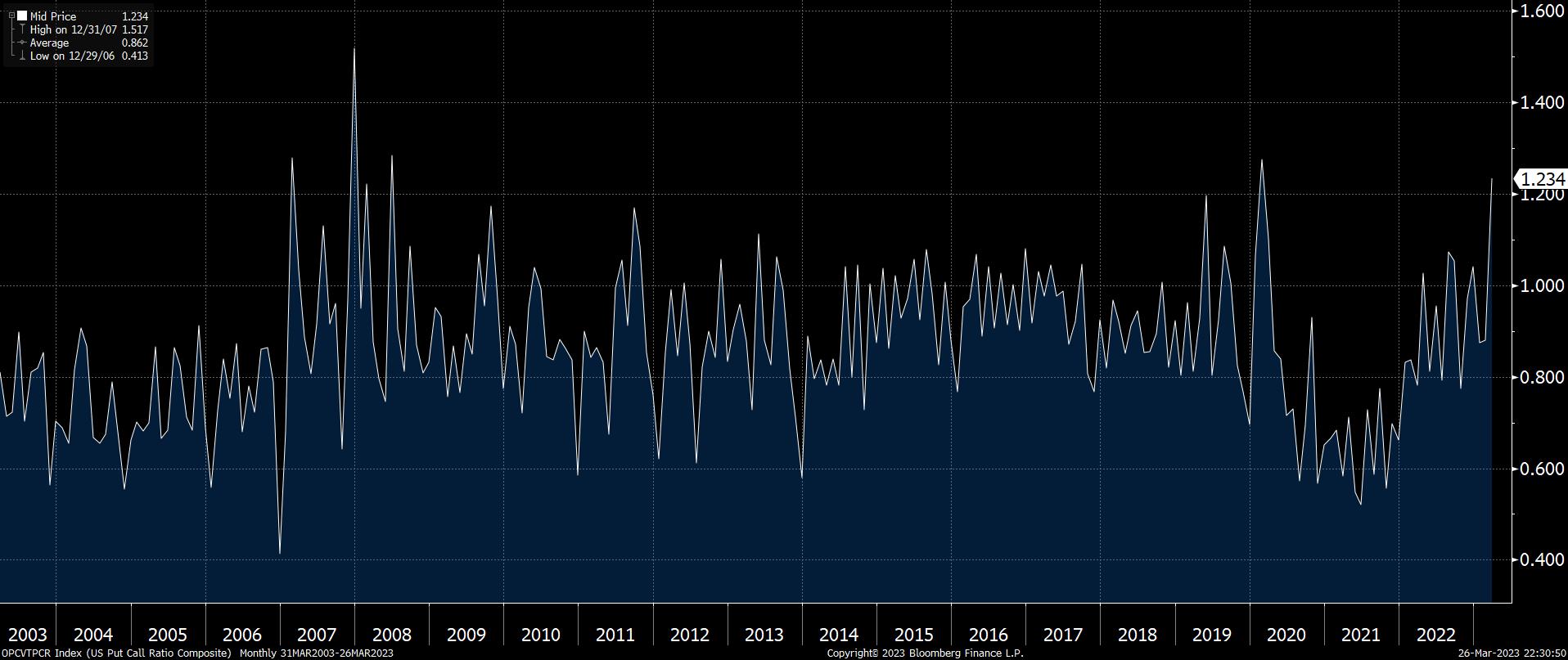Tennis is a thrilling sport where competitors must anticipate their opponents’ movements and make split-second judgments based on their observations. A parallel can be drawn to the financial markets, as investors strive to predict and manage quickly shifting circumstances.
This week’s chart depicts the U.S. Put Call Ratio Composite (OPCVTPCR Index), which represents the ratio of total put option volume to call option volume. As of March 26, the ratio stood at 1.2, meaning that the total volume of put options was greater than the number of call options.
Investors may use this indicator to assess market sentiment and forecast future market moves. The ratio peaked above 1.5 on Dec. 31, 2007, shortly before the global financial crisis — which was brought on by a number of causes, including a housing bubble and irresponsible lending practices.
It is interesting to note that the current level of 1.2 or above has only been seen three other times in the past 20 years: February 2007, June 2008 and February 2020, right at the onset of the COVID-19 pandemic. This data shows that market downturns driven by macroeconomic risks tend to make investors rush to hedge their portfolios by buying puts as a form of downside protection.
On the other hand, during periods of market prosperity, the index trends below 1, indicating that more calls are being bought over puts, with an average of 0.862 over the last 20 years. This suggests that investors are more optimistic about market conditions during such times.
Recent economic and market developments have pushed investors to explore strategies to hedge their downside, and the most recent Federal Reserve (Fed) move has placed many balance sheets through another stress test. Against a backdrop of bank mergers and failures, financial institutions have tightened credit lending. These developments are beginning to mimic the circumstances that preceded the 2008 global financial crisis, with this week’s chart demonstrating how investors have reacted.
Key Takeaway
According to the U.S. Put Call Ratio Composite, macroeconomic developments and present market circumstances are causing a rise in unfavorable sentiment. Investors seem to be attempting to anticipate a down market in the same way that athletes aim to predict the actions of their rivals.
The material provided here is for informational use only. The views expressed are those of the author, and do not necessarily reflect the views of Penn Mutual Asset Management.
This material is for informational use only. The views expressed are those of the author, and do not necessarily reflect the views of Penn Mutual Asset Management. This material is not intended to be relied upon as a forecast, research or investment advice, and it is not a recommendation, offer or solicitation to buy or sell any securities or to adopt any investment strategy.
Opinions and statements of financial market trends that are based on current market conditions constitute judgment of the author and are subject to change without notice. The information and opinions contained in this material are derived from sources deemed to be reliable but should not be assumed to be accurate or complete. Statements that reflect projections or expectations of future financial or economic performance of the markets may be considered forward-looking statements. Actual results may differ significantly. Any forecasts contained in this material are based on various estimates and assumptions, and there can be no assurance that such estimates or assumptions will prove accurate.
Investing involves risk, including possible loss of principal. Past performance is no guarantee of future results. All information referenced in preparation of this material has been obtained from sources believed to be reliable, but accuracy and completeness are not guaranteed. There is no representation or warranty as to the accuracy of the information and Penn Mutual Asset Management shall have no liability for decisions based upon such information.
High-Yield bonds are subject to greater fluctuations in value and risk of loss of income and principal. Investing in higher yielding, lower rated corporate bonds have a greater risk of price fluctuations and loss of principal and income than U.S. Treasury bonds and bills. Government securities offer a higher degree of safety and are guaranteed as to the timely payment of principal and interest if held to maturity.
All trademarks are the property of their respective owners. This material may not be reproduced in whole or in part in any form, or referred to in any other publication, without express written permission.


